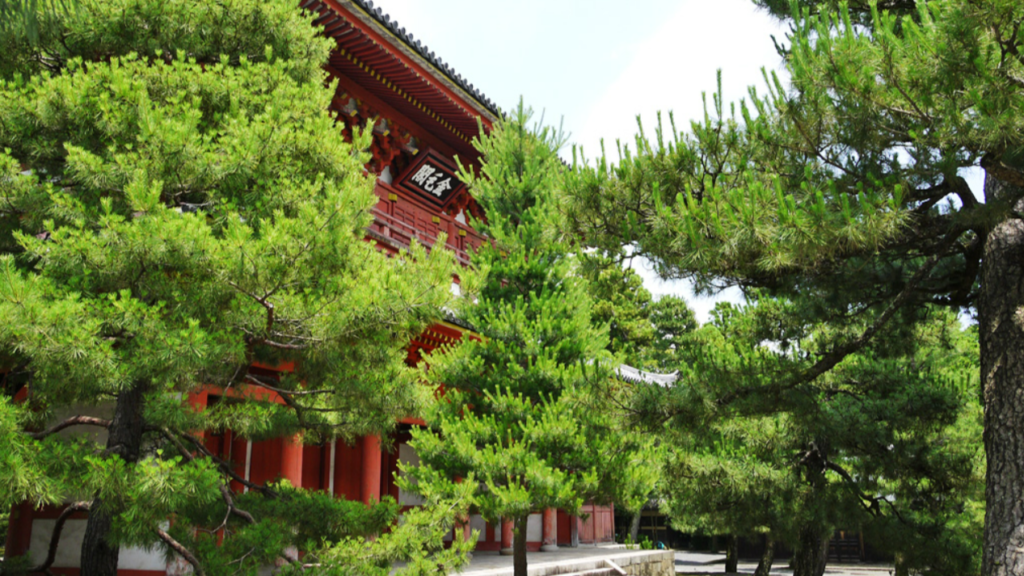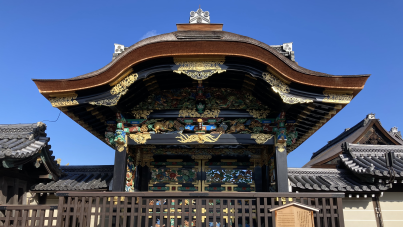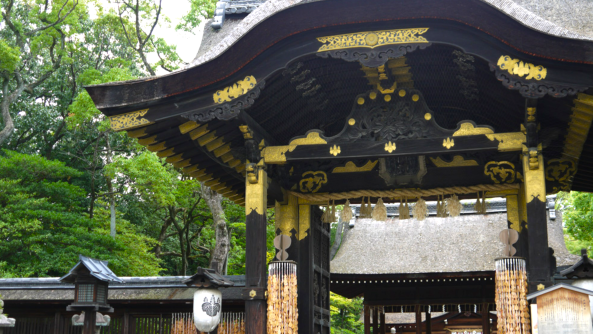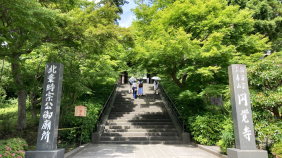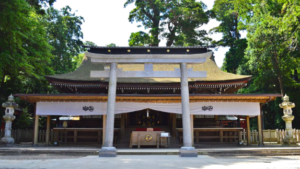Three Karamon Gates Reflect Hideyoshi's Authority as a Ruler
Kyoto is home to three national treasures of Karamon Gates at Daitokuji Temple, Nishi-Hongwanji Temple, and Toyokuni Shrine. These gates were relocated from Toyotomi Hideyoshi’s retreats, Jurakudai and Fushimi Castles. Toyotomi Hideyoshi (1537–1598, 豊臣秀吉) ended over a century of warlike period in Japan. The Karamon Gates feature the distinctive Karahafu, an undulating bargeboard on the gable on the top. Richly adorned with several gold works and many carvings such as cranes, kirin, peacocks, and carp climbing waterfalls as a symbol of success. These gates are splendid, decorative, and gorgeous. Notably, the crane sculpture has no eyes to prevent it from “flying away,” reflecting its lifelike detail.
Hideyoshi Seized on a Glorious Chance to Rise to the Ruler
Hideyoshi had confronted the Mori clan in the western area of Japan since 1577 on the order of his lord, Oda Nobunaga (1534-1582, 織田信長). This was Nobunaga’s final battle to unify the nation. During its seesaw struggle for more than five years, Nobunaga was killed suddenly by his vassal, Akechi Mitsuhide (1528-1582, 明智光秀) at Honnoji Temple in Kyoto in 1582. Hideyoshi rushed back to Kyoto and successfully defeated Mitsuhide. As a result of his victory, he took the lead to become Nobunaga’s successor against other vassals.
Soon Hideyoshi started to build Osaka Castle on the Uemachi Plateau which Nobunaga had seized from Osaka Hongwanji Temple in an 11-year battle. It was the traffic point to expand Nobunaga's rule into the western area through the Seto Inland Sea. It's said that Hideyoshi wanted to show himself as Nobunaga's successor to the samurai world by building this castle larger and more splendid than Nobunaga's Azuchi Castle. Hideyoshi consolidated his power after his victory against Nobunaga’s senior vassal, Shibata Katsuie (1522-1583, 柴田勝家), in the following year. However, he was desperate to have several lords to serve at his feet tooth and nail.
Hideyoshi’s Miracle Idea to Rule Japan by the Position of Kanpaku
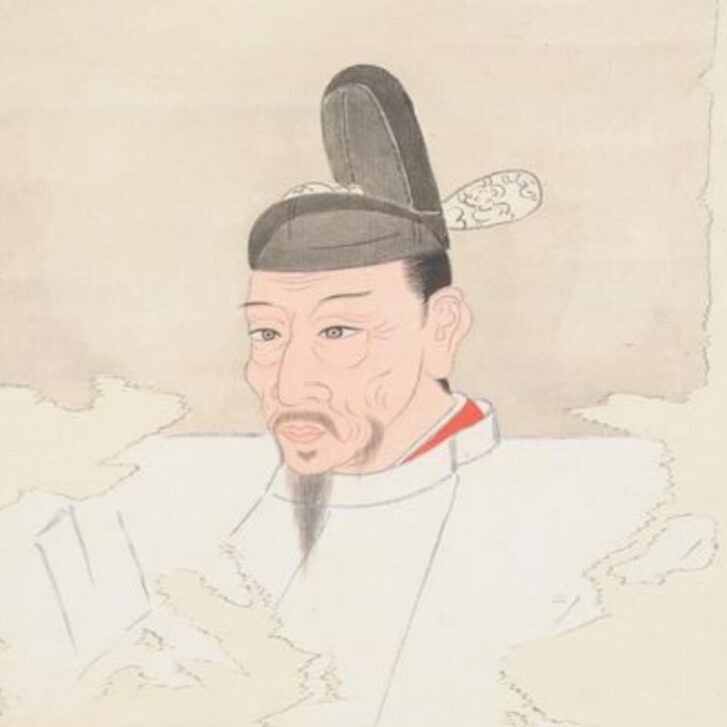
@都城島津邸
The staunch opponent of Hideyoshi was Tokugawa Ieyasu (1543-1616, 徳川家康), who was an ally of Nobunaga. In 1584, Hideyoshi failed to defeat Ieyasu at the Battle of Komaki and Nagakute. As a result, Hideyoshi’s main territory was the area in western Japan, where Ieyasu ruled eastern Japan. This was a major setback for Hideyoshi to become the country's ruler by force. On this occasion, Hideyoshi sought to elevate his status by becoming Kanpaku, a chief advisor to the emperor, in 1585. He assumed Kanpaku and started to control Japan by utilizing the prestige of the Imperial Court. This was unprecedented in history. Hideyoshi employed various strategies to get Ieyasu serve to him, who persistently resisted, to submit as his vassal. In May 1586, Hideyoshi arranged the marriage of his sister, Asahi, to Ieyasu, and in October, he sent his mother as a hostage. Nine days later, Ieyasu finally went to Osaka Castle to meet Hideyoshi and bowed before Hideyoshi.
The Remains of Jurakudai and Fushimi Castle
In the following year, Hideyoshi hosted the 70th Emperor Go-Yozei (1571-1617, 後陽成天皇) at his new flamboyant residence, Jurakudai, located west of the Kyoto Imperial Palace. During this event, Ieyasu and 29 lords pledged their loyalty to Emperor Go-Yozei, in the sworn oath. The third chapter stated, “Do not act against the Kanpaku Hideyoshi”. This act marked Hideyoshi’s declaration that he conquered the nation. At this time, Hideyoshi was 50 years old. Two years later, in 1590, Hideyoshi launched an attack on the Hojo clan, the last resisting military lord, and captured at Odawara castle, thereby finally achieving Hideyoshi’s long-held ambition to unify Japan.
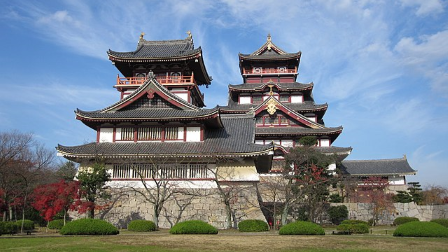
Afterward, Hideyoshi handed the position of Kanpaku over to his nephew, Toyotomi Hidetsugu (1568-1595,豊臣秀次), despite his earlier promise to return the title to the court nobles. He then moved to and resided in the newly constructed Fushimi Castle in Kyoto at age 56, where he lived until his death at age 62. As he faced death, Hideyoshi requested to be worshipped as a guardian deity of samurai, but this was denied by the Imperial Court. Instead, his spirit was enshrined as a modest deity at the Toyokuni Shrine in Kyoto. Following Hideyoshi’s death, Tokugawa Ieyasu defeated the Toyotomi Family and established the Tokugawa Shogunate in Edo (Tokyo) in 1603, when he was appointed Shogun. Ieyasu implemented several measures to preserve the peace.
Karamon Gates Evoke Hideyoshi's Heyday
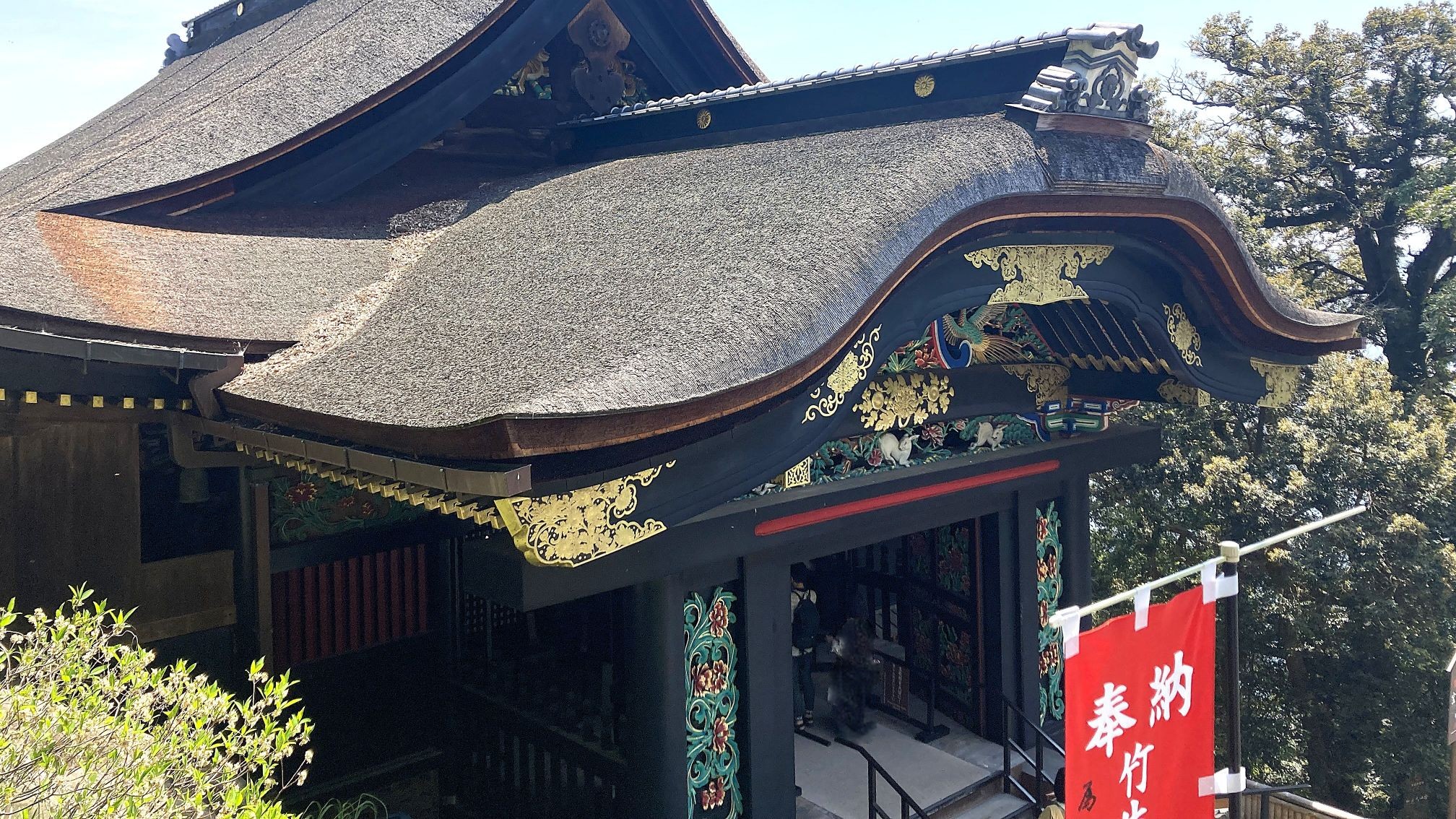
Many buildings of Jurakudai were demolished and relocated to Fushimi Castle by Hideyoshi. After his death, several structures from Fushimi Castle were moved to other locations, such as Nishi-Hongwanji Temple and Toyokuni Shrine. These Karamon Gates are reminiscent of Hideyoshi's heyday achieved from a peasant to the Kanpaku with own his wit and strong will to make an end to the turbulent age that had lasted for about 140 years. This was also the ambition of his lord, Oda Nobunaga. Another Karamon at Hoganji Temple in Shiga Prefecture is the only remnant of Osaka Castle, as it was burned down during the Siege of Osaka between Hideyoshi's heir, Hideyori, and Tokugawa Ieyasu. You can see the crowning glory of the Toyotomi clan's heyday in front of the Karamon Gates.
Toyotomi Hideyoshi Timeline
| 1537 | Hideyoshi was born in Nagoya | Age=1 | Warring State Period |
| 1554 | Hideyoshi started to work under Nobunaga | 17 | |
| 1582 | Nobunaga was killed at Honnoji by Akechi Mitsuhide | 45 | Azuchi Momoyama Period |
| 1582 | Hideyoshi defeated Akechi Mitsuhide | 45 | |
| 1585 | Hideyoshi became Kanpaku (chief advisor to the Emperor) | 48 | |
| 1586 | Hideyoshi built the huge Osaka castle | 49 | |
| 1587 | Hideyoshi built Jyurakudai as his residence | 50 | |
| 1590 | Hideyoshi spearhead army to attack Hojo clan | 53 | |
| 1590 | Hideyoshi unified the nation | 53 | |
| 1594 | Hideyoshi built the Fushimi Castle | 57 | |
| 1598 | Hideyoshi passed away | 61 |
Recommendations to Visit
Daitokuji Temple
- Access: Take Kyoto Subway bound for ”Kokusai Kaikan (国際会館)" Get off at the "Kitaoji (北大路)" subway station. Take bus #206 bound for Kyoto Sation. Get off at "Daitokuji-mae (大徳寺前)”.
Nishi Honganji Temple
- Access: 10 minutes from Kyoto Station. Take bus #9 bound for "Nishigamo Shako-mae(西賀茂車庫)” at B1 or bus #28 bound for "Daikakuji (大覚寺)" at C6. Get off at "Nishi Honganji-mae(西本願寺前)" bus stop
Toyokuni Shrine
- Access: Take bus #86, #88, or #206 at D2 of Kyoto Station. Get off at the "Hakubutsukan Sanju-Sangendo-mae (博物館三十三間堂前)" bus stop, then a 5-minute walk.
Hoganji Temple
- Access: A 10-minute walk from JR Nagahama Station to Nagahama Port. A 25-minute boat to Chikubu Island

